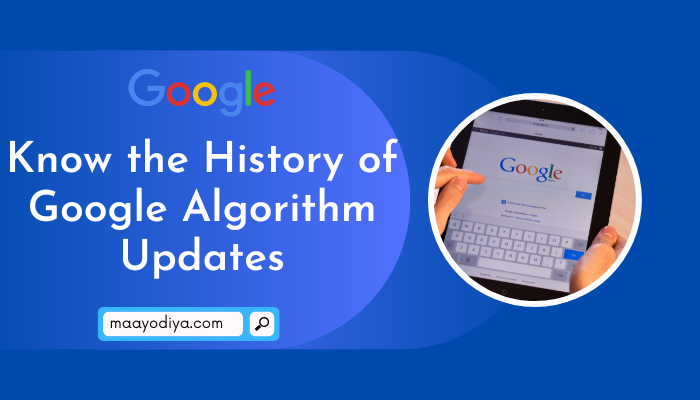
Let’s take a look at the history of Google algorithm updates, and get an understanding of what they are. To start with, this article will examine the history of updates to Google algorithm and identify what they do. But before that, it is important to note that since 2001, Google has made approximately 500 adjustments in their algorithm. The basic idea behind these changes is to make the web index more precise as a way of improving search results for users of the Google search engine. This article mainly focuses on how Google’s algorithms have changed over time and how they function.
Google Algorithm Updates: What are they?
Google Algorithm Updates are changes to the way Google’s search engine ranks websites. These updates can be major or minor, but they all have one goal: to improve the quality of search results for users.
Some of the most famous Google Algorithm Updates include:
– Panda: This update was designed to target low-quality content and websites. It caused a major shakeup in the SEO world, and led to many sites seeing a drop in their search rankings.
– Penguin: Another update focused on low-quality content, Penguin targeted sites that were engaging in black-hat SEO tactics like keyword stuffing and link farms.
– Hummingbird: Hummingbird was a complete overhaul of Google’s ranking algorithm, and was designed to better understand the user’s intent when they perform a search.
These are just a few of the many Google Algorithm Updates that have been released over the years. As Google continues to strive for excellence in their search results, we can expect even more updates in the future.

Difference Between Penguin and Panda
Google has made several algorithm updates over the years, with the most notable being Penguin and Panda. Both of these updates had a major impact on the SEO landscape and changed the way that Google ranks websites.
Penguin was first announced in 2012 and was designed to target sites that were using black-hat SEO techniques, such as keyword stuffing and link buying. Penguin caused a major shakeup in the SEO world, as many sites that were previously ranking well suddenly found themselves plummeting in the search results.
Panda was released shortly after Penguin and also targeted sites that were using low-quality content. Unlike Penguin, which only affected a website’s search rankings, Panda could actually cause a website to be completely removed from Google’s search results.
Both Penguin and Panda were major changes to Google’s algorithm, and both had a significant impact on the SEO landscape. If you’re interested in learning more about these updates, or other Google algorithm updates, You can join Maayodiya Academy for learning SEO which is best digital marketing course.
Penguin Update History
Google Penguin was 1st announced on April 24, 2012. This algorithm update was designed to target sites that were violating Google’s Webmaster Guidelines by engaging in black-hat SEO tactics like keyword stuffing, link buying, and excessive link exchange.
Since its initial release, Penguin has undergone several updates. The most recent update, Penguin 4.0, was released in September 2016. This update marked a significant change to the way Penguin works, as it is now incorporated into Google’s core algorithm.
Penguin 4.0 was a welcome update for many webmasters, as it finally gave them the ability to recover from a Penguin penalty. Prior to this update, any site that was hit by Penguin would need to wait for a new algorithm update to be released before they could hope to recover their rankings.
If you’re interested in learning more about Google Penguin and its history, I recommend checking out this article from Moz.
Panda Update History
Google Panda was first introduced in February 2011 as a way to improve the quality of search results. The update was aimed at reducing the ranking of low-quality websites and returning higher-quality results to users.
Panda has undergone several updates over the years, with the most recent one being released in July 2015. The update made several changes to the algorithm, including making it more difficult for sites with thin content to rank high in search results.
If you want to stay up-to-date this type of evergreen digital marketing content, make sure to check out our blog section or you can also bookmark our Maayodiya blog.
March 2024 Google Updates
In March 2024 Google released a bunch of updates to improve the user experience and the search engine itself. One of the biggest updates is the search algorithm. The goal of this update is to make the search experience more intuitive and user-friendly by improving the understanding of natural language searches. You can expect more accurate and relevant results as Google’s AI gets better. Along with the algorithm update Google also focused on core web vitals, page load speed, interactivity and visual stability. These updates are important for both user experience and SEO as it means websites have to meet higher performance standards.
Google AI experiments on Reddit
Google has been experimenting with AI on various platforms including Reddit. By using natural language processing and machine learning Google’s AI can process massive amounts of user generated content on Reddit. This helps Google to get deeper insights into trending topics and public sentiment. The AI goes through millions of discussions to find the key themes and emerging trends which can inform the search algorithms and ad strategies. This not only refines Google’s search and ad services but also creates a feedback loop to improve the AI models further. These experiments show Google’s commitment to using AI to understand and predict user behavior so their services can be more responsive and user centric.
Google AI experiments on LinkedIn
On LinkedIn Google is experimenting with AI on professional networking and career development. The AI driven tools are to help with better job matching and skills identification, connect users with relevant opportunities and industry peers more effectively. The tools parse resumes and job descriptions using AI to provide recruiters and job seekers with exact recommendations. Additionally AI is analyzing professional interactions and content on LinkedIn to give personalized insights and networking suggestions. This shows Google’s commitment to using AI to improve user experience across different platforms. By making people search, connect and interact online better Google is driving innovation in the digital world.
Read Also: How To Upgrade Digital Marketing Skills
Conclusion
Google algorithm updates are a part of life for anyone who relies on Google for their traffic. It’s important to stay up-to-date on the latest changes so that you can adjust your SEO strategy accordingly. This article has given you a brief overview of some of the most significant updates in recent years. Keep this history in mind as you continue to monitor Google’s ever-changing landscape.
FAQs: History of Google Algorithm
What was the first big Google algorithm update?
The first big Google algorithm update was PageRank. It was released in 1998 and ranked pages based on the number and quality of links to them, basically the importance of the page.
What is the Google Panda update?
The Google Panda update was released in February 2011 and was designed to demote low quality sites with thin or duplicated content and promote high quality sites.
How were search results affected by the Penguin update?
Released in April 2012, the Penguin update targeted sites that used black-hat SEO tactics like keyword stuffing and link schemes to manipulate their rankings.
What was the Hummingbird update for?
The Hummingbird update was released in August 2013 and was designed to improve search queries, especially long tail queries, by using natural language processing to give more relevant results.
What does the RankBrain algorithm do for Google?
Released in October 2015, RankBrain is a machine learning part of the algorithm that processes and understands search queries. It gives more relevant results by understanding the intent behind the queries, especially the complex and ambiguous ones.


